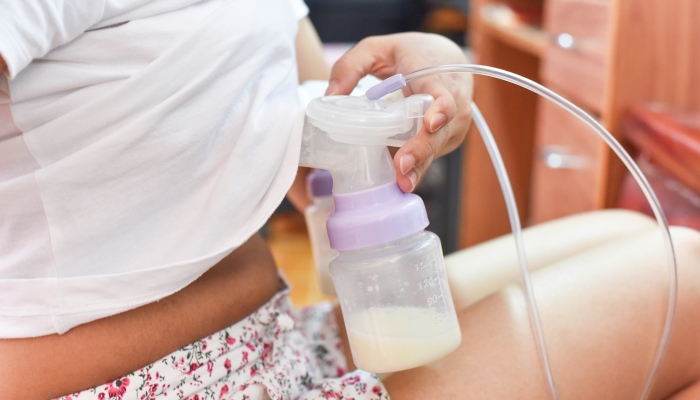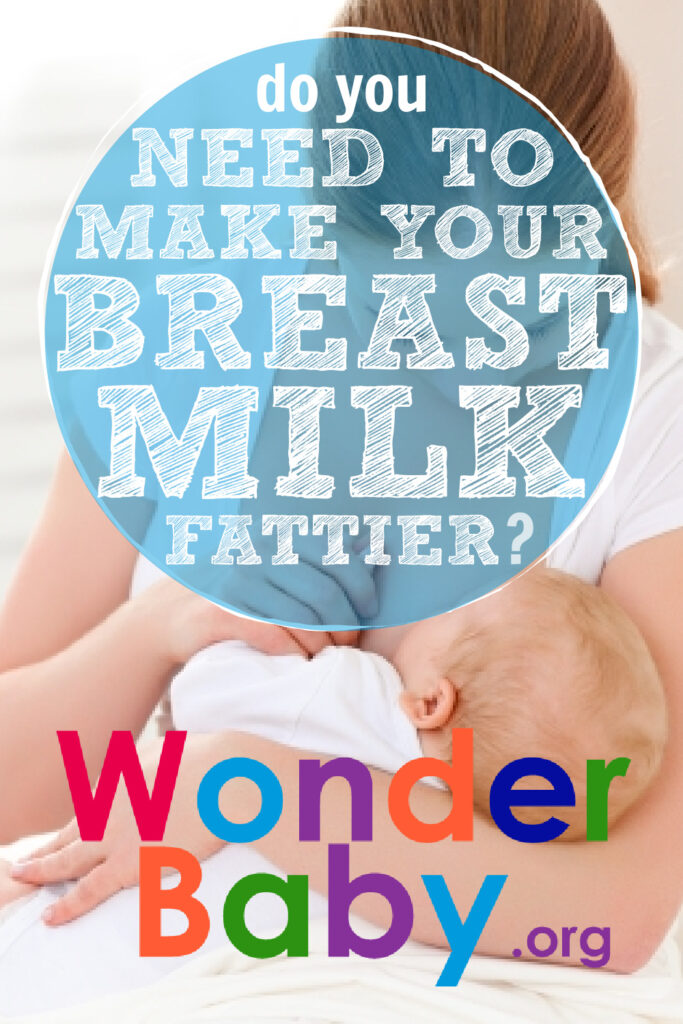Do You Need To Make Your Breast Milk Fattier?

- Breast milk is versatile: Your body easily adjusts your breast milk production based on your baby’s needs.
- Hind milk is fattier milk—it contains more fat, proteins, vitamin A, and vitamin E.
- Your breast milk contains enough of nearly all the nutrients your newborn will need—including fat.
- Taking breast milk supplements as early as the sixth month of pregnancy helps produce fatty milk.
- Add one to two portions of fish every week to your meals to increase the fat content of your milk.
Lots of first-time breastfeeding mothers worry about whether they have enough milk or whether their breast milk has a low-fat content. This is because breastfeeding isn’t an exact science—you can’t tell how much breast milk your baby’s taken, let alone how much milk your breasts make in the first place!
Your baby will rely the most on your milk’s fat content for energy, growth, and overall development. While your body will produce a lot of milk on its own, it’s important to know how to help make your breast milk fattier so that your baby will always receive the right amount of nutrients and energy throughout your breastfeeding days.

Breast Milk Content
Breast milk is made up of nutrients, bioactive substances, and commensal bacteria. Bioactive substances help build the immune system, while commensal bacteria are “good bacteria” that help keep the gut healthy and the immune system active. The following is a list of substances found in breast milk:
| NUTRIENTS: | BIOACTIVE SUBSTANCES: | COMMENSAL BACTERIA: |
|---|---|---|
| Water | Human milk oligosaccharides (HMOs) | Lactobacillus |
| Carbohydrates | Immunoglobulins | Bifidobacterium |
| Fats | White blood cells | Streptococcus |
| Proteins | Antimicrobial proteins | |
| Vitamins | ||
| Minerals |
Breast Milk: Nutrient Content
There are two main types of nutrients in breast milk: macronutrients and minerals. Macronutrients include carbohydrates, protein, and fat, while examples of minerals are calcium and phosphorus.
What makes breast milk special is that it’s versatile: your body easily adjusts your breast milk production based on your baby’s needs. For example, if your baby is sick or was born preterm, your body knows which nutrients to add or how to increase milk production.
Breast milk also adapts to your baby’s age from birth to the first few weeks. For the first two to four days, your body produces a special type of breast milk called colostrum. This milk is rich in whey proteins and some minerals but is low in lactose, calcium, potassium, and fats.
Breast milk adjusts its content from “colostrum” to “mature milk” during your baby’s first two weeks of life. According to a 2014 study, 100 ml of mature milk contains about 7 grams of lactose, 3 grams of fat, 1 gram of protein, and 60-70 calories.
Among these nutrients, breast milk fat is the primary source of energy—babies get 50% of their energy from breast milk fat alone.
What’s the Difference Between Foremilk and Hindmilk?
The amount of nutrients your baby gets during breastfeeding will also change, depending on the time of day, and whether you’re starting or finishing a feeding session. The type of breast milk at the start of feeding is called foremilk, while breast milk at the end of feeding is called hind milk.
Foremilk is the milk your baby gets for the first few minutes after milk letdown. This has more lactose and only about 2% of breast milk fat content. Its consistency is also much thinner.
The rest of the remaining milk until the feeding stops is called hind milk. This is fattier milk—it contains more fat, proteins, vitamin A, and vitamin E. Sometimes hind milk can have as much as 6% of breast milk fat content, up to three times more than foremilk. Its consistency is creamier than foremilk.
As of writing, there’s no proven reason why hind milk has more fat globules than foremilk. A scientific review done by Bobiński and Bobińska in 2020 came up with a theory as to why this happens: as your baby continues to breastfeed, their mouth draws in your nipple more and more, causing more flat globules created by your milk ducts to be pulled into the milk at the end of the feed.
In terms of time, studies have shown that moms produce fattier breast milk during the afternoons and evenings.

What Are the Benefits of Breast Milk Fat?
Breast milk contains natural, healthy fats. This is in the form of lipid droplets, also known as fat globules, which carry fatty acids, cholesterol, proteins, and bioactive substances. Breast milk fat plays an important role in your baby’s growth and development. It contains both saturated fats and unsaturated fats, but these are both healthy and safe for your child. These are some of the benefits your child can get from breast milk fat:
- Good energy source (as much as 50% of their daily energy needs)
- Absorption of minerals, like calcium and magnesium
- Healthy development of your baby’s stomach and intestines
- Decreased chance of constipation
- Decreased chance of obesity when they become adults
- Healthy brain development
- Healthy development of the spine and nerves
- Healthy development of your child’s eyes
- Reduces unhealthy inflammation in the body
- Stronger immune system
- Healthy development of the hormonal system
- Better digestion and metabolism of other energy sources, like carbohydrates and proteins
- Better taste (of breast milk)
Does Your Breast Milk Contain Enough Fat?
Mother’s milk contains nearly all the nutrients your newborn will need, and that includes fat. A 2016 journal says that breast milk supply “is almost always adequate in essential nutrients for… term infant’s growth and development”.
Like other moms, you might be wondering if your milk has enough fat content for every feeding session. Fortunately, your baby starts to receive their share of fatty acids a few months before they’re born. During your third trimester of pregnancy, some polyunsaturated fatty acids are already being passed on through the placenta and umbilical cord.
The amount of fat your breast milk has will vary depending on the type of milk. Between colostrum, transitional milk, and fatty hindmilk, the fat content ranges from 4 to 27%. Regardless of the percentage of content, it will always contribute to at least 50% of the energy your baby needs every day.
Regardless of your current diet, your body will make breast milk fattier by using its own reserves of fatty acids. In fact, the fat content increases between the second and sixth months after giving birth. Don’t worry too much about whether your baby’s taking in enough fat—while your breast milk already has enough, there’s nothing wrong with eating healthy foods to boost or make breast milk fattier.
It’s important to consider your diet to make sure that your body doesn’t have a hard time increasing the fat in breast milk. There are two important polyunsaturated fats in breast milk: ARA and DHA. The amount of ARA in breast milk doesn’t vary so much, but DHA levels in breast milk depend on a healthy diet.
You should be able to take in 200 to 300 mg of polyunsaturated fatty acids (especially DHA) every day. Oily or fatty fish, like salmon and tuna, are good sources to increase the fat content of your milk.

Factors That Affect Your Breast Milk’s Fat Content
Mother’s Diet
Your diet is probably the most well-known factor affecting how much fat you’ll have in your breast milk. Several milk supplements help increase the fat content of your milk. Long-chain polyunsaturated fat and choline supplements lead to more healthy fats in breast milk.
Diet is not the only factor that can change the amount of fat in your overall milk supply.
Breastfeeding Practices
Studies show that the amount of fat in breast milk is higher if feeding sessions with your little one last longer. Using the same breast your baby last latched on to for the next feed will also increase your baby’s fat intake.
Breastfeeding Boys Versus Girls
Research by Lee et al. (2018) has shown that baby boys receive more phospholipids, a type of fat found in breast milk, compared to baby girls. It’s still unknown why this happens, and further studies are needed to discover more about the relationship between phospholipids and baby boys.
Birth Outcomes
If your baby was born preterm or with low birth weight, you are more likely to produce fattier milk. Fatty breast milk provides more energy as a way to make up for all the nutrition your baby missed out on. Long-term-wise, this helps your baby with gaining weight and catching up with their overall development.
Genetics
Some genes involving milk enzymes can determine how much fat (phospholipids) your body makes and how easily these pass through milk ducts. Not everyone expresses these genes the same way. Most doctors don’t think it’s necessary to check for these specific genes.
Make Your Breast Milk Fattier and Healthier
Before pregnancy, most women would need only 1,600 to 2,400 calories per day. In breastfeeding moms, this increases to 2,000 to 2,800 calories per day.
While breast milk adjusts to your baby’s needs, don’t forget that you will also need to help your body produce more milk and increase fat content. This makes your milk supply your baby’s best source of nutrients, which includes fat.
Take Supplements Early
Taking breast milk supplements as early as the sixth month of pregnancy helps produce fatty milk. Taking alpha-linolenic acid (ALA) supplements from the sixth month of pregnancy until your baby turns six months old will help increase DHA levels in your breast milk.
If you are on a vegan or vegetarian diet, try to take daily multivitamins and DHA supplements. Make sure to see your doctor first on your next prenatal check-up.
Eat More Fish
Add one to two portions of fish every week to your meals. Herring, salmon, and tuna are good sources of healthy fats and are less likely to have heavy metal contaminants compared to other types of fish.

The information WonderBaby provides is not intended to be, and does not constitute, medical or other health advice or diagnosis and should not be used as such. Always consult with a qualified medical professional about your specific circumstances.
Related Posts

Breastfeeding, Sleep
Sleep and Breastfeeding: A Comprehensive Guide for Nursing Moms
Many people assume breastfeeding and sleep training don’t go together, but it is possible to help your baby sleep better while continuing your breastfeeding journey.

Breastfeeding
Comfort Nursing: Pros, Cons, and How to Stop
Find out what comfort nursing is, when should you worry about it, and how to stop or limit your baby's comfort nursing (especially at night!).

Breastfeeding, Product Reviews
5 Best Breastfeeding Chairs for Nursing Moms of 2023
Whether you want a gentle rock, a smooth glide, or a cozy cuddle to soothe your baby to sleep, you’ll have your pick of the best breastfeeding chairs on the...